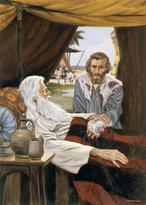 |
| Candlemass Offertory |
Hebrew Bible, Old Testament The History of Its Interpretation - Google Books
A Word
in Season - Reading by St Ambrose,- newer Edition commentary of ST
HILARY OF POITIERS.
Placing the commentaries of Hilary (315-367) and Ambrose
(339-397) in columns impress on us the patristic biblical styles succeeding in 30
years. 367-397.
Ambrose zealously combatted imperial court
attempts at favoritism to the parties of Arians, the "old" religion,
and the Jews, particularly opposing the favors from Emperor
Valentinian who supported the Arians. In defending the Orthodox position he has
often been compared to St. Hilary of
Poitiers.
Ambrose is ranked with the great Western
Christian leaders of the time: Augustine, St. Jerome, St. Gregory the
Great, and St. Hilary of
Poitiers. Ambrose was most known for his administrative talents,
given his education and early experience before becoming a bishop. Yet, like
Hilary he was an Alexandrian and was in the forefront in the doctrinal issues
of the day, particularly those concerning Arianism. His sermons were famous and
were influential in the conversion of Augustine. His endeavors in hymn writing became models of hymns of dignified simplicity for
future times. Ambrose is credited with introducing antiphonal chanting wherein
one choir alternates with another. Of particular note is that Ambrose baptized
Augustine, his celebrated convert.
G_oxWSQEVcC&pg=PA682&lpg=PA682&dq=Hilary+of+Poitiers+and+Ambrose+of+Milan,+compare&source=bl&ots=CXIgEKZOba&sig=
Hebrew Bible, Old Testament: The History of Its
Interpretation
Vandenhoeck & Ruprecht, 1
Dec 1996 - Bible - 847
pages
The first volume of
the series Hebrew Bible / Old Testament deals with questions of the canon with
regard to its interpretation from the Jewish, New Testament, rabbinic, and
patristic point of view, and encompasses the time up to Augustine. It ends with
a synopsis on Church and Synagogue as the respective matrix for the development
of authoritative text interpretation.
page 682-3
Chapter Twenty
The Reception of the
OriginistTradition in Latin Exegesis
By Christoph Jacob Munster
Allegory and the Text of the Bible
Hilary of Poitiers and Ambrose of Milan are considered to be the
two theologians in the Latin West who by their personal fate or by the the
thoroughness of their education learned to know the Origenist interpretation of
Scripture, assumed it wholeheartedly and paved the way for subsequent Latin
exegesis.
p. 287 x 4
p. 688
In the conclusion to the
treatise on the mysteries, Hilary
speaks about the difficulties of allegorical interpretation in general: it is
not easy to discern whether a certain passage of Scripture is to be understood
as a simple event as a simple historical narrative or in the typical sense: the
knowledge of the simple event is corrupted if treated vainly as a prophecy and
its transfiguration dynamic is destroyed if it is considered as a historical
fact only. (25 Cf Tractatus mysteriorum I. 13). This is said to be one of the
wisest statements of Christian antiquity. (26 J. Danielou, Saint Hilaire eveque
et docteur 1968)
This may be correct; it would be wrong, however, to trust J.
Danielou’s introductory remark: he believes he has discovered here a
distinction between allegory and ‘typology’. But Hilary does not oppose a “true exegesis”, i.e. an ecclesiastical
typology, to an allegorical or literal understanding of Scripture. This the
distinction of Danielou is trying to promote. Hilary rather speaks of the general difficulty arising from the
decision about suitability of an historical or a spiritual reading of the
Bible. One may n fact approve of the question raised by Hilary, but it is not possible to claim him to be an adherent of a ‘typological
exegesis’ as opposed to allegorical interpretations. His question is more
fundamental, asking about the meaning of ‘holy’ Scripture as such.
... It is not only a matter of
historical justice to appreciate the hermeneutics of Hilary and Ambrose even if it differs essentially from the position
of modern exegesis.
Ambrose and Hilary use allegorical
techniques in order to get away from a semantical reading of the Bible. They
regard Scripture as a crystal being able to reflect interpretations Christological
or ecclesiastical issues. These different
interpretations do no harm to this crystal and at the same time its transparency
is not complete: it scatters the light shining through it and gives rise to its
many different colours. Is not this exactly the objective of allegorical
expositions of the Bible.
Contents:
20. The Reception of the Origenist Tradition in Latin Exegesis
By CHRISTOPH JACOB, Munster
1. Allegory and the Text of the Bible
2. Hilary of Poitiers
2.1. The Fullness of His Exegetical Work
2.2. The Bible in the Christological Debates
3. Ambrose of Milan :
3.1. Towards the Principles of His Exegesis
3.2. Allegorica dissimulatio: the Ambrosian Rhetoric
3.3. The Song of Songs in Ambrosian Allegory
4. Allegory and Interpretative Pluralism












